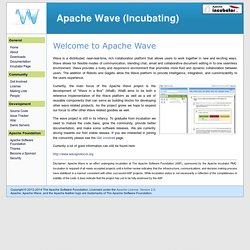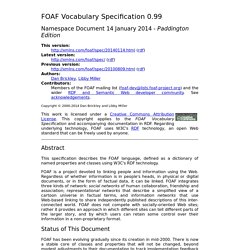

TimelineJS Template - Google Docs Templates. OpenCalais. Wave - Welcome to Apache Wave (incubating) Wave is a distributed, near-real-time, rich collaboration platform that allows users to work together in new and exciting ways.

Wave allows for flexible modes of communication, blending chat, email and collaborative document editing in to one seamless environment. Wave provides a lively and responsive environment that promotes more fluid and dynamic collaboration between users. The addition of Robots and Gagets allow the Wave platform to provide intelligence, integration, and customizability to the users experience. Currently, the main focus of the Apache Wave project is the development of "Wave in a Box" (WiaB). WiaB aims to be both a reference implementation of the Wave platform as well as a set of reusable components that can serve as building blocks for developing other wave related products.
The wave project is still in its infancy. Currently a lot of good information can still be found here: Krr.cs.vu.nl/wp-content/uploads/2013/09/protege-fuseki-yasgui-manual.pdf. Knowledge Representation and Reasoning Group - News and Updates on the KRR Group. Whitepaper: The ClioPatria Semantic Web server. What is ClioPatria?

ClioPatria is a (SWI-)Prolog hosted HTTP application-server with libraries for Semantic Web reasoning and a set of JavaScript libraries for presenting results in a browser. Another way to describe ClioPatria is as Tomcat+Sesame (or Jena) with additional reasoning libraries in Prolog, completed by JavaScript presentation components''. Why is ClioPatria based on Prolog? Prolog is a logic-based language using a simple depth-first resolution strategy (SLD resolution).
This gives two readings to the same piece of code: the declarative reading and the procedural reading. Below we define this query as a Prolog predicate. :- rdf_register_ns(foaf, ' name_mbox(Name, MBox) :- rdf(X, foaf:name, literal(Name)), rdf(X, foaf:mbox, MBox). We can run this query interactively from the terminal as illustrated below. ?
Returning all solutions is all that is provided by the SPARQL query. ? ? Employee_name_email(List, MBox, Name) :- rdf(List, list:member, MBox), name_mbox(Name, MBox). ? FOAF Vocabulary Specification. Classes Class: foaf:Agent Agent - An agent (eg. person, group, software or physical artifact).

The Agent class is the class of agents; things that do stuff. A well known sub-class is Person, representing people. Other kinds of agents include Organization and Group. The Agent class is useful in a few places in FOAF where Person would have been overly specific. [#] [back to top] Class: foaf:Document Document - A document. The Document class represents those things which are, broadly conceived, 'documents'. The Image class is a sub-class of Document, since all images are documents. We do not (currently) distinguish precisely between physical and electronic documents, or between copies of a work and the abstraction those copies embody. [#] [back to top] Class: foaf:Group Group - A class of Agents.
The Group class represents a collection of individual agents (and may itself play the role of a Agent, ie. something that can perform actions). Here is an example. <! [#] [back to top]